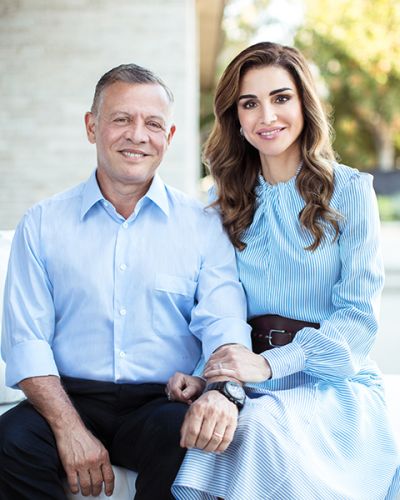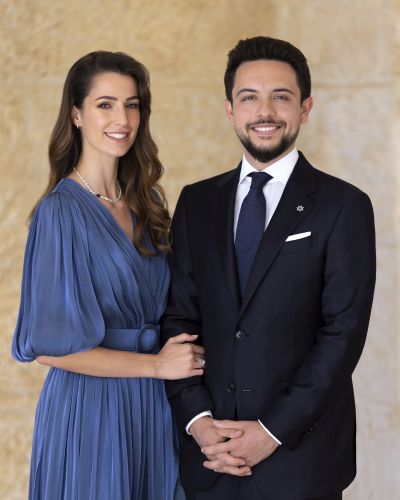Last modified: 16 January 2024
The country
The state is known as Al-‘Urdunn in its national language. This means the Hashemite Kingdom of Jordan. The country is being reigned by the Hashemite dynasty.
The Hashemite Kingdom of Jordan long before BC existed of several kingdoms. The most prominent ones were the ones of Ammon (Amman), Moab and Edom. While the other kingdoms on Jordanian soil were conquered by the Assyrian empire, the Kingdom of Ammon remained independent. The Nabatean Kingdom of Petra rose in southern Jordan in the time of Alexander the Great, but was sieged by the Roman Empire in 103 AD. Jordan became part of the Umayyad Empire in the 7th and 8th century, and afterwards from 750 to 1258 was occupied by the Abbasids. After the Abbasids the country was ruled by among others the Mongols, Crusaders, Ayyubids, Mamlukes and Ottomans (around 1517). After the fall of the Ottoman Empire at the end of World War I the Middle East was divided in a French and a British Mandate. More than 70% of the British Mandate of Palestine was situated east of the Jordan river and known as Transjordan. In 1925 Transjordan was created a successor state of the Ottoman Emmpire, as established by the Council of the League of Nations. The mandate over Transjordan ended on 22 May 1946.
The Hashemite Kingdom of Transjordan became independent on 25 May 1945, and was in 1950 renamed the Hashemite Kingdom of Jordan. The first king, Abdullah I, was shot in Jerusalem on 20 July 1951 while visiting the Al Aqsa Mosque. His grandson Prince Hussein bin Talal survived the attack. King Talal bin Abdullah succeeded his father, but was deposed in 1952 because he was mentally ill. Therefore in 1953, on his 18th birthday, Hussein bin Talal became King of Jordan. Only two weeks before his death, on January 25th, 1999, King Hussein appointed his eldest son Abdullah as Crown Prince. Abdullah became King of Jordan after the death of his father. King Abdullah II is reportedly the 43th generation direct descendant of the prophet Mohammed.


Sovereign
The current sovereign is Abdullah II bin Al Hussein, King of Jordan. He was born at Amman, Jordan, on 30 January 1962. He was Crown Prince of Jordan from his birth to 1965, and again as of 25 January 1999.
He is the son of King Hussein bin Talal of Jordan (1935-1999) and his second wife Antoinette Gardiner (1941- ), who is known as Princess Muna.
Enthronement
Abdullah II succeeded his father upon his death on 7 February 1999.
Abdullah II was sworn in at the Parliament in Amman, Jordan, on 7 February 1999. The coronation took place at the Throne Hall, Raghadan Palace, Amman, on 9 June 1999.
Other details
The King is a Muslim (Sunni).
Marriage and descendants
King Abdullah II is married to Rania Al Yassin (born 1970) since 1993.
Their children:
- Crown Prince Hussein (born 1994)
- Princess Iman (born 1996) is married to Jameel Alexander Thermiotis (born 1994) since 2023.
- Princess Salma (born 2000).
- Prince Hashem (born 2005)
Heir to the throne
Crown Prince Hussein bin Abdullah of Jordan was born in Amman, Jordan, on 28 June 1994.
Hussein has been Crown Prince since 2 July 2009. The previous Crown Prince, from 7 February 1999 to 28 November 2004 was Abdullah II’s halfbrother Prince Hamzah (born 1980).
He is married to Rajwa Al-Saif (born 1994) since 2023.
Postal address
The Royal Hashemite Court
P.O. Box 5166
11183 Amman
Jordan
Succession
Jordan is nowadays a constitutional monarchy with representative government.
The King is the head of state. He is the supreme commander of the land, naval and air forces. According to the Constitution of Jordan the throne is hereditary in a direct male line. The title of King shall pass from the holder of the throne to his eldest son. In case the eldest son dies before he has succeeded to the throne, his eldest son will inherit the throne. The King however may select one of his brothers as heir apparent, in which case the throne will pass to him. If the king dies without a male heir, the throne will pass to his eldest brother. In case there are no brothers, the throne will pass to the eldest son of the eldest brother. If the eldest brother has no son, the throne will pass to the eldest son of the other brothers according to seniority in age. In absence of brothers or nephews the throne will pass to uncles and their descendants. In case the king dies without any heir the throne will devolve upon the person selected by the National Assembly among the descendants of the late King Hussein ibn Ali, founder of the Arab Revolt.
A king or heir can only succeed to the throne when he is a Muslim, mentally sound and born by a legitimate wife and of Muslim parents. Persons can be excluded from succession by a Royal Decree on the ground of unsuitability, which has to be signed by the reigning King, the Prime Minister and four ministers (including the ones of Interior and Justice). This doesn’t include the descendants of this person. A King reaches his majority upon the completion of his 18th year. In case someone who succceeds the throne hasn’t reached majority yet, the powers of the King will be exercised by a regent or council of regency, that is appointed by a Royal Decree by the reigning king. If there is no king to make a nomination, the council of ministers will appoint the regent or council of regency. In case a King is unable to exercise his powers due to illness, the powers will be exercised by a vice-regent or council of vice-regents, that are appointed by Royal Decree. If a King leaves the country he has to appoint a vice-regent or a council of vice-regents by Royal Decree before his departure. A regent, vice-regent or member of the council of regency have to take an oath before the council of ministers before assuming office. They at least have to be 30 years old. However any male relative of the King who is 18 years old or older can be appointed. If a King is incapable because of a mental illness, the council of ministers has to convene the National Assembly immediately after the illness has been confirmed. The National Assembly in that case can depose the King by resolution. The throne will then go to the first person in line of succession. Upon succession the King has to take an oath before the National Assembly.
Titles
The King is styled His Majesty and is by the help of God, King of the Hashemite Kingdom of Jordan. His wife, the Queen, is styled Her Majesty. The Crown Prince (Wali al-Ahd) is styled His Royal Highness. Male descendants in male line are Prince and His Royal Highness. Female descendants in male line are Princess and Her Royal Highness. The King can grant personal titles to more remote relatives and connections. Their title is Amir and they are styled His Highness, Prince … The female form is Amira.
Royal residences
The royal palaces and offices of the Jordan royal family are established at the Maqar (headquarters). This is the place where the armies of the Arab revolt camped when they liberated Amman in 1918. King Abdullah I in the early 1920s took residence in central Amman, but that area wasn’t regarded as very suitable. In 1925 the reconstruction of the present site was started on a hill in the old sector of Amman. The Raghadan Palace was built in 1926. The roof was destroyed in a fire in 1983 and was renovated afterwards. The palace also contains the Throne Hall. The building is now used for official engagements like visits of heads of state and dignitaries, audiences and working meetings.
Among the palaces in the Royal Court compound is the Basman Palace, which was built in 1950. The palace contains the offices of the King and some other members of the royal family. Queen Rania’s office is situated at the Al-Qasr Al-Sagheer Palace. Queen Dowager Noor lives at the Bab As-Salaam palace, where she also lived with her husband King Hussein. Her offices are at the Qasr Al-Ma’wa palace. The Nadwa Palace is used as guest palace. The former British residence at the compound is the home of Prince El Hassan and Princess Sarvath of Jordan. The royal cemetery is also located in the Royal Court compound.
Since 2005 King Abdullah II and Queen Rania live at the Beit al-Urdun residence outside Amman. They previously lived at the Beit al-Baraka residence. The family also have a house in Aqaba, called Beit al-Bahr.
The Kings of Jordan
| Abdullah I (1882-1951) | 1921/46-1951 |
| Talal (1909-1972) | 1951-1952 |
| Hussein (1935-1999) | 1952/53-1999 |
| Abdullah II (1962- ) | 1999- |
Links
- His Majesty King Abdullah II ibn al Hussein
- Queen Rania Al Abdullah, Hashemite Kingdom of Jordan
- The Royal Hashemite Court on Facebook
- The Royal Hashemite Court on Twitter
- Royal Hashemite Court on Instagram
- The Royal Hashemite Court on YouTube
- Royal Hashemite Court on Flickr
- Queen Rania on Facebook
- Rania Al Abdullah on Twitter
- Queen Rania Al Abdullah on Instagram
- Queen Rania on YouTube
- Rania Al Abdullah on Flickr
- His Royal Highness Crown Prince Al Hussein bin Abdullah II
- Al Hussein bin Abdullah II on Instagram
- Crown Prince Foundation
- A living tribute to the legacy of King Hussein I
- King Hussein Foundation
- Noor Al Hussein Foundation
- Noor Al Hussein on Twitter
- Princess Alia Foundation
- Feisal Ibn AlHussein
- Ali Al Hussein on Twitter
- The official website of HRH Prince Hamzah Bin Al Hussein
- Hamzah bin AlHussein
- Raiyah Bint Al Hussein on Twitter
- Ned Donovan on Twitter
- El Hassan bin Talal
- HRH Prince El Hassan bin Talal
- Her Royal Highness Princess Basma Bint Talal
- Ghida Talal on Twitter
- Princess Ghida Talal on Facebook
- Princess Firyal of Jordan
- Princess Firyal of Jordan on Facebook
- Firyal of Jordan on Twitter
- HRH Princess Firyal of Jordan on Instagram
- Jaafar on Twitter
- Jaafar on Facebook
- Jaafar on Instagram
- Jaafar on Soundcloud
- Jaafar on Spotify
- Jaafar on YouTube
